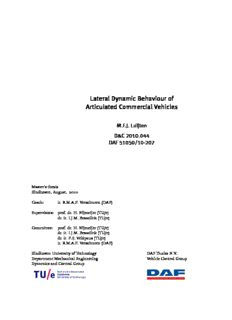
Lateral Dynamic Behaviour of Articulated Commercial Vehicles PDF
Preview Lateral Dynamic Behaviour of Articulated Commercial Vehicles
Lateral Dynamic Behaviour of Articulated Commercial Vehicles M.F.J. Luijten D&C 2010.044 DAF 51050/10-207 Master’sthesis Eindhoven,August, 2010 Coach: ir. R.M.A.F.Verschuren(DAF) Supervisors: prof. dr. H.Nijmeijer(TU/e) dr. ir. I.J.M.Besselink(TU/e) Committee: prof. dr. H.Nijmeijer(TU/e) dr. ir. I.J.M.Besselink(TU/e) dr. ir. F.E.Veldpaus(TU/e) ir. R.M.A.F.Verschuren(DAF) EindhovenUniversityofTechnology DAFTrucksN.V. DepartmentMechanicalEngineering VehicleControlGroup DynamicsandControlGroup Abstract Additional to the conventional tractor-semitrailer, truck-centre axle trailer and truck-full trailer combinations, Ecocombi’s (longer and heavier truck combinations) have been introduced pre legislatively as an experiment in the Netherlands. Electronic stability control functions are ap- plied on trucks to enhance safety. The challenge of designing such functions is to guarantee robustness for all truck variations, such as lay-out, length, mass, number of axles and number of articulations. Therefore, fundamental understanding of the effect of these variations on the dynamicyawbehaviourofarticulatedvehiclesisrequired. Linearsingletrackvehiclemodelsare usedinthisstudytogainthisfundamentalinsight. Stability analysis reveals that when the cornering stiffness scales linearly with vertical load and whenlegalaxleloadsareobeyed,theconventionalvehiclecombinationshardlybecomeunstable in yaw. The measure stability does not show explicit differences between the vehicle combina- tions. Therefore, the performance measure rearward amplification is used, which is a measure for the amount of lateral acceleration amplification. A frequency domain approach is applied as the results of this approach are better reproducible than the results of a time domain approach whichisoftenusedinliteraturetocalculaterearwardamplification. Asmallervalueforrearwardamplificationindicatesabetterdynamicperformanceofthecombi- nation. Thiscanbeachievedingeneralbydecreasingthedistancebetweenthecentreofgravity ofthetowingvehicleandthecouplingpoint,byincreasingthedrawbarlengthandtrailerwheel- base, by applying multiple axles and by placing the axles per group further apart. Furthermore, a semitrailer results in a relatively small rearward amplification value in relation to the other combinations, as its trailer wheelbase is relatively large. For a centre axle trailer, adding inertia resultsinalargerrearwardamplificationvalueofthisunit. Afulltrailerhasmainlyakinematic coupling with its towing unit when the steering dolly mass and inertia are assumed to be zero. In this case, the parameters of the trailer have no effect on the dynamics of the towing vehicle. Finally, especially for Ecocombi’s it is important to model the amount of axles in relation to the lengths,massesandinertiasoftheunits. The results presented in this report pertain to optimal driving conditions. It is recommended to investigate the effect of excitations of the truck other than the steering wheel input on the dynamicperformanceoftruckcombinations. i ii Samenvatting Ecocombi’s (langere en zwaardere vrachtwagencombinaties) worden toegestaan als proef in Ne- derland, naast de conventionele tractor-oplegger, bakwagen-middenasaanhanger en bakwagen- molenasaanhanger. Elektronische stabiliteitsregelingen worden toegepast op vrachtwagens om de veiligheid op de weg te verbeteren. De uitdaging voor het ontwerp van zulke functies is het garanderenvanrobuustheidvoorallevariaties,zoalslay-out,massa,lengte,aantalassenenaan- talgeledingen. Onderwerpvandezestudieishetverkrijgenvaneenfundamenteelinzichtinde dynamische gierstabiliteit van gelede voertuigen, zodat de invloed van variaties beter begrepen wordt. Hiertoezijnlineaireenkelsporigevoertuigmodellengebruikt. De conventionele vrachtwagens blijken bijna niet instabiel te krijgen te zijn, wanneer de band- stijfheidlineairschaaltmetdelastopdebandenwanneeraandetoegestanemaximaleaslasten voldaanwordt. Demaatstabiliteitlaatgeenduidelijkonderscheidzientussendevoertuigcombi- naties. Erisdaaromeenmaatvoordegierdempingtoegepast. Eenfrequentiedomeinaanpakis gebruikt,omdatderesultatenvandezeaanpakbeterreproduceerbaarzijndanderesultatenvan eentijddomainaanpakwelkevaakindeliteratuurgebruiktwordt. De prestatie van een combinatie wordt beter naarmate de gierdemping toeneemt. In het alge- meenmoethiervoorhetkoppelpuntdichtbijhetzwaartepuntvanhetvoorvoertuiggeplaatstwor- den,moetendedisselendewielbasisvandetrailerlangzijn,moetenmeerdereassentoegepast wordenenmoetendezeassenveruitklaargeplaatstworden. Bovendienzorgteenopleggervoor veel gierdemping vergeleken met de andere trailers, omdat de wielbasis van deze aanhanger re- latieflangis. Deprestatievaneenmiddenasaanhangerneemtafwanneerhettraagheidsmoment in de trailer toeneemt. Een molenasaanhanger is voornamelijk kinematisch gekoppeld met zijn voorwagenwanneerdemassaenhettraagheidsmomentvandestuurdollyverwaarloostkunnen worden. In dit geval hebben de parameters van de trailer geen invloed op de dynamica van het voorvoertuig. TenslotteishetvooralvoorEcocombi’sbelangrijkomhetaantalassenindecombi- natietemodellereninrelatietotdelengtevanhetvoertuig,demassaenhettraagheidsmoment. De resultaten van deze studie gelden voor optimale condities. Het wordt aanbevolen om onder andere de invloed van een aanstoting van het voertuig anders dan de stuurwielhoek te onder- zoeken. iii iv Notation Abbreviations CAT Truck-centreaxletrailer cog Centreofgravity FRF Frequencyresponsefunction FT Truck-fulltrailer lc lanechange RA Rearwardamplification Semi Tractor-semitrailer Tyre,axleandvehiclesymbols α Tyreslipangle rad a β,β˙ = r Yawangleofthetowingvehicle rad 1 δ Steeringwheelangle rad v η Understeercoefficient - v φ Relativeanglebetweenthefirstarticulationandthetowingvehicle rad ψ Relativeanglebetweenthesecondandfirstarticulation rad ρ Relativeanglebetweenthesecondarticulationandthetowingvehicle rad θ,θ˙ = r Yawangleofthefirstarticulation rad 2 ξ,ξ˙= r Yawangleofthesecondarticulation rad 3 a Distancefromthefrontofthearticulationtothecentreofgravity m v a Lateralacceleration m/s2 yv b Distancefromthecentreofgravitytotherearaxle m v C Totalcorneringstiffnesstowingvehicle N/rad C Axlecorneringstiffness N/rad a C Totalcorneringstiffnessfulltrailer N/rad t C Tyrecorneringstiffness N/rad Fα C Nominalaxlecorneringstiffness N/rad nom e Distancebetweentherearaxleandthecouplingpoint m v f Normalisedtyrestiffnesscoefficient 1/rad a F Lateraltyre/axleforce N ya F Verticaltyre/axleforce N za v F Nominalverticalforce N znom fact Momentcontributionfactorformultipleaxles - h Distancebetweenthecentreofgravityandthecouplingpoint m v I Momentofinertia kgm2 v j Halfdistancebetweentwoaxlesinanaxlegroup m k Radiusofgyration m v l∗ Distancebetweenthefrontofthearticulationtothecouplingpoint m v l Wheelbase m v m Mass kg v q Averagetyremomentarm m v R Pathradius m S Neutralsteerpoint s Distancefromcogorhitchpointtoneutralsteerpoint m v x Distancebetweenthecentreofgravityandanaxlegroup m Othersymbols λ Eigenvalue ω (Natural)frequency rad/s ζ Dampingratio - A Statespacesystemmatrix s B Statespaceinputmatrix s c ith coefficientofthecharacteristicequation i C Statespaceoutputmatrix s D Dampingmatrix D Statespacefeedthroughmatrix s D Denominatorofthecriticalspeed c den Denominatorofatransferfunction F Inputmatrix f Frequency Hz r g Gravitationalacceleration m/s2 H ith Hurwitzdeterminant i H (ω) Transferfunction;inputx,outputy y,x I Unitymatrix j Complexvariable,j2 = −1 M Massmatrix n Maximumnumber,numberofaxlesinanaxlegroup num Nominatorofatransferfunction Q Generalisedforces N q Generalisedcoordinate T Kineticenergy J U Potentialenergy J V Characteristicspeed m/s char V Criticalspeed m/s crit x Statevector Subscripts’a’referenceaxles a = 1 Frontaxletowingvehicle a = 2 Rearaxletowingvehicle vi a = 3 Axlefirstarticulation a = 4 Axlesecondarticulation f Frontaxle r Rearaxle Subscripts’v’referencevehiclearticulations v = 1 Towingvehicle v = 2 Firstarticulation v = 3 Secondarticulation Coordinatesystem r Yawvelocity rad/s v u Forwardvelocity m/s v Lateralvelocity m/s v vii viii
Description: